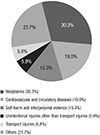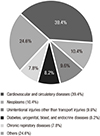1. Jung YH. Measuring years of life lost due to premature death in Korea: toward estimating the burden of diseases. Health Welf Policy Forum. 2011; 11:66–74.
2. Oh IH, Yoon SJ, Kim EJ. The burden of disease in Korea. J Korean Med Assoc. 2011; 54:646–652.
3. Murray CJ, Vos T, Lozano R, Naghavi M, Flaxman AD, Michaud C, Ezzati M, Shibuya K, Salomon JA, Abdalla S, et al. Disability-adjusted life years (DALYs) for 291 diseases and injuries in 21 regions, 1990-2010: a systematic analysis for the global burden of disease study 2010. Lancet. 2012; 380:2197–2223.
6. Yoon SJ, Oh IH, Seo HY, Kim EJ. Measuring the burden of disease due to climate change and developing a forecast model in South Korea. Public Health. 2014; 128:725–733.
7. The Korean Society for Preventive Medicine. Preventive Medicine and Public Health. 2nd ed. Seoul: Gyechukmunhwasa;2013.
8. Lozano R, Naghavi M, Foreman K, Lim S, Shibuya K, Aboyans V, Abraham J, Adair T, Aggarwal R, Ahn SY, et al. Global and regional mortality from 235 causes of death for 20 age groups in 1990 and 2010: a systematic analysis for the global burden of disease study 2010. Lancet. 2012; 380:2095–2128.
10. Chang H, Myoung JI, Shin Y. Burden of disease in Korea: years of life lost due to premature deaths. Korean J Prev Med. 2001; 34:354–362.
11. Yoon SJ, Jo MW, Park HS, Oh IH, Kim BS, Kim DW, Yoon JH, Ko SK, Kong YH, Jung JH, et al. A Study on Measuring and Forecasting the Burden of Disease in Korea. Cheongju: Ministry of Health and Welfare;2015.
12. Murray CJ, Lopez AD. The Global Burden of Disease: a Comprehensive Assessment of Mortality and Disability from Diseases, Injuries and Risk Factors in 1990 and Projected to 2020 (Global Burden of Disease and Injury Series Vol. 1). Cambridge, MA: Harvard University Press;1996.
13. Naghavi M, Makela S, Foreman K, O'Brien J, Pourmalek F, Lozano R. Algorithms for enhancing public health utility of national causes-of-death data. Popul Health Metr. 2010; 8:9–22.
15. Hotez PJ, Dumonteil E, Woc-Colburn L, Serpa JA, Bezek S, Edwards MS, Hallmark CJ, Musselwhite LW, Flink BJ, Bottazzi ME. Chagas disease: “the new HIV/AIDS of the Americas. PLoS Negl Trop Dis. 2012; 6:e1498.
16. GBD 2013 Mortality and Causes of Death Collaborators. Global, regional and national age-sex specific all-cause and cause-specific mortality for 240 cause of death, 1990-2013: a systematic analysis for the global burden of disease study 2013. Lancet. 2015; 385:117–171.
17. Statistics Korea. Korean standard statistical classification [Internet]. accessed on 11 September 2015. Available at
http://kssc.kostat.go.kr.
18. Jung YH. Avoidable mortality in Korea. Health Welf Policy Forum. 2014; 8:42–53.
19. Murray CJ, Richards MA, Newton JN, Fenton KA, Anderson HR, Atkinson C, Bennett D, Bernabé E, Blencowe H, Bourne R, et al. UK health performance: findings of the global burden of disease study 2010. Lancet. 2013; 381:997–1020.
20. Bradshaw D, Pillay-Van Wyk V, Laubscher R, Nojilana B, Groenewald P, Nannan N, Metcalf C. Cause of Death Statistics for South Africa: Challenges and Possibilities for Improvement. Cape Town: South African Medical Research Council;2010.
 is life expectancy at the age of x, l is age at death, and dx is the death rate at the age of x.
is life expectancy at the age of x, l is age at death, and dx is the death rate at the age of x.










 PDF
PDF Citation
Citation Print
Print










 XML Download
XML Download